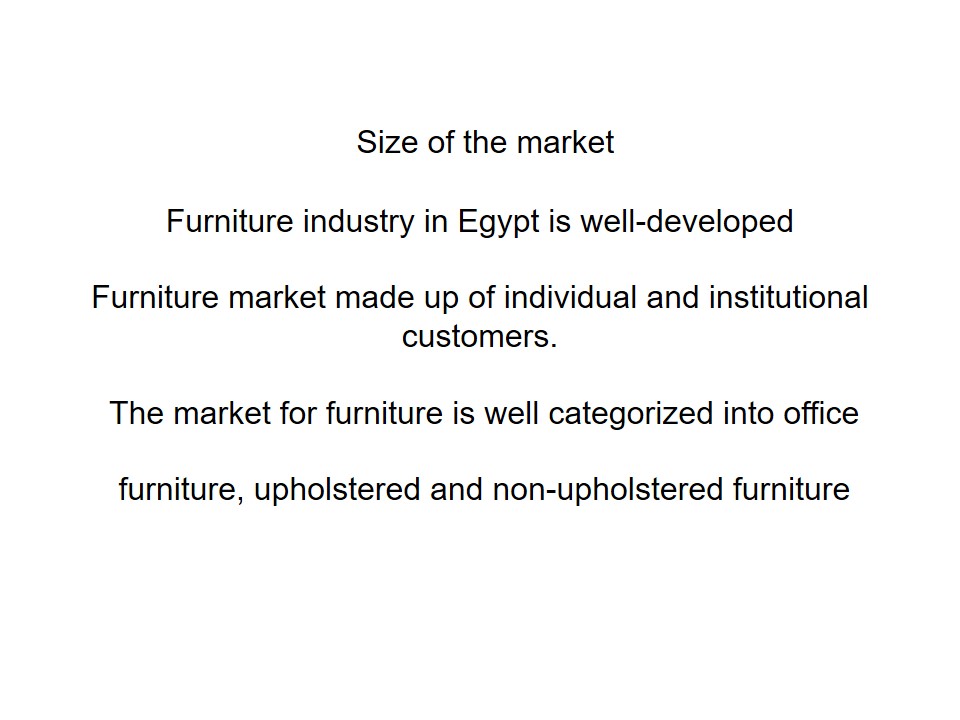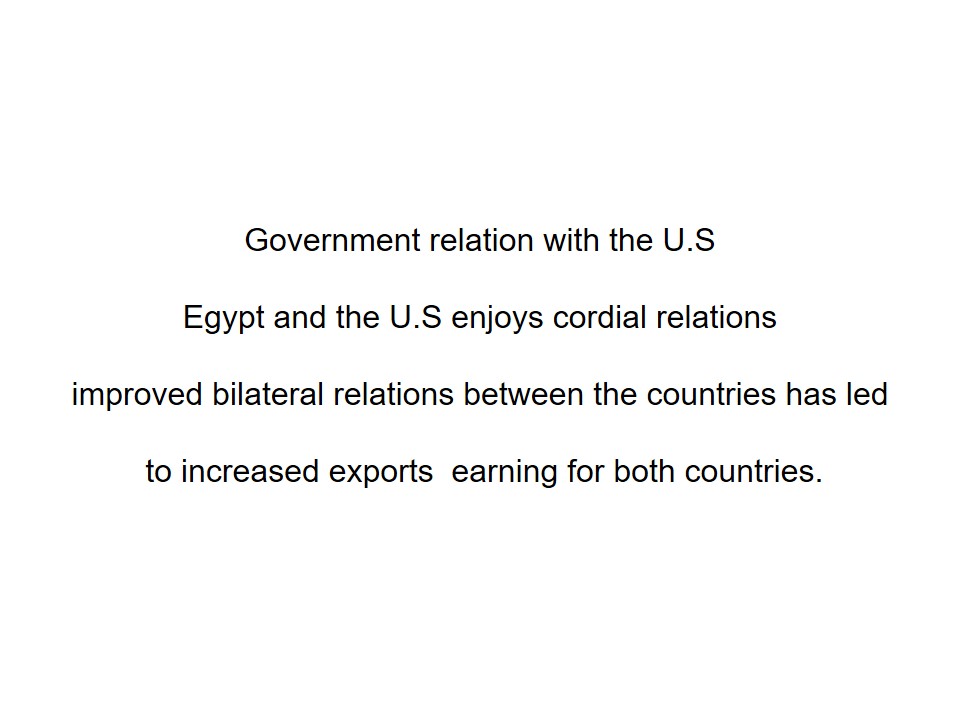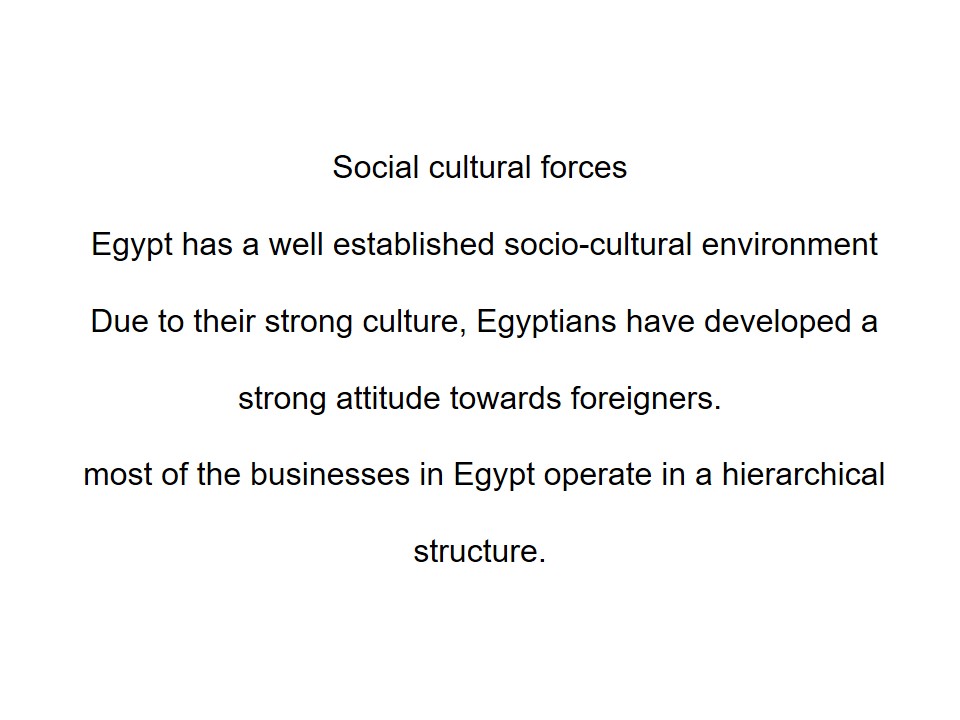Introduction: Involvement in the furniture industry firm’s objective internationalization strategy venturing into Egypt.
Amnox is a private limited company which is located in Washington, US. The firm deals with designing and production of various furniture products. One of the products that the firm deals with is the designing and production of the couch which is a furniture designed for seating by an average of 2 to 4 people. Over the past few years, the firm has been successful in its operation within its domestic market by selling its products to both individual and institutional customers. The firm’s management team is committed towards attaining its profit maximization objective by increasing its sales revenue. Currently, the domestic market has become very competitive as a result of more domestic and foreign investors venturing the industry. Increase in the intensity of competition has posed a challenge to the firm’s objective to remain competitive in its domestic market. In an effort to attain its profit maximization and competitive objectives, the firm’s management team has considered evaluating a number of strategies. Through an extensive analysis of the best strategies, the firm’s management team has come to a consensus to incorporate the concept of internationalization through exportation. This will contribute towards the firm offsetting the cyclical nature of sales in its domestic market. The firm’s management team has settled at Egypt as its foreign market destination. In selecting the foreign market, the firm’s management team undertook a comprehensive market research to determine its feasibility. This paper entails an export business plan in relation to the couch.

Product description synthetic leather couch use of top grain leather material
- The couches are also made from a variety of high quality fabric materials which are easy to clean.
- The leather and fabric materials used are of different colors in order to meet the market needs.
- A variety of artistic designs are also incorporated in the leather and fabric materials used to make the couch.
In its operation, the firm’s management team is committed at ensuring that the consumers receive a high level of satisfaction. To attain this, the management ensures that quality is incorporated in the entire process of designing and production of the couch. The couch is specially produced by incorporating various designs in order to appeals different customer tastes and preferences. In addition, a variety of quality materials are used in its production. Some of the materials used in the production of the couch include synthetic leather. Use of leather material is integrated due to its elastic characteristic which enables the couch to retain its shape after stretching. This makes the couch to be comfortable. Top grain leather material which is the outer layer of extracts from leather is used in producing the couch. Use of top grain leather makes the coach to be sensual, comfortable, genuine and elegant. In addition, use of leather makes the couch to be durable. The couches are also made from a variety of high quality fabric materials which are easy to clean. On the other hand, the leather used is easy to polish. The leather and fabric materials used are of different colors in order to meet the market needs. A variety of artistic designs are also incorporated in the leather and fabric materials used to make the couch. To enhance durability of the couch, a variety of hard wood are used.

Characteristic of the target market
- Egypt’s per capita income has increased in recent years.
- Egypt’s has a per capita income of $ 5,400.
- Egypt’s per capita GNP has been positive.
Over the past 9 years, Egypt has witnessed an increment in its economic growth. As a result, the country’s per capita income has greatly been enhanced. According to as study which was established in 2008, Egypt had a per capita income of $ 5, 400 which is relatively high (Henn, 2010, p. 1). A high level of per capita income plays a significant role in enhancing the consumer’s purchasing power. The country has witnessed a positive growth rate in its GNP per capita resulting from a high rate of economic growth.

Size of the market
- Furniture industry in Egypt is well-developed.
- Furniture market made up of individual and institutional customers.
- The market for furniture is well categorized into office furniture, upholstered and non-upholstered furniture.
Egypt has a well developed furniture industry resulting from its large market size (Tunesi, 2008, p. 1). Both individual and institutional cusptomers constitute the size of furniture market in Egypt. Some of the major institutional customers that the management of the firm has targeted include hookah lounges, hotels and restaurants. In an effort to improve customer experience, most of these institutions are upgrading their furniture by integrating modern seats. The market for furniture is well categorized into office furniture, upholstered and non-upholstered furniture. This enables the firm’s in this industry to satisfy their customer demands.

Market Screening
In order to conduct its exportation business successfully, the management of the firm conducted a comprehensive market screening to by considering a number of market variables.

Basic needs
Potential high rate of economic growth in Egypt has increased consumer purchasing power the need to integrate modern de signs in furniture has arisen consequently, customer demand for furniture has increased.
Considering the high rate of economic growth that Egypt has witnessed over the past years, the consumers’ purchasing power has been enhanced. As a result, there has been a positive shift in consumers purchasing behavior. A large proportion of individual consumers have considered integrating modern furniture designs in their purchasing patterns. This has culminated into an increment in demand for furniture which is directly related to the level of income. It is projected that the demand for furniture in Egypt will increase in the future (Fully furnished, 2007, Para. 10). According to industry analysts, it is expected that a 10% increase in the level of consumers’ income will translate into a 15% increase in the level of demand. Despite the high quality of Egyptian furniture, firms in this industry have not integrated the concept of customer service effectively (El-Meehy, 2002, p. 16). This has resulted into poor problem solving by firms in the furniture industry in relation to furniture products.

Exchange rate trends in Egypt
- Egypt has adopted a pegged exchange rate regime.
- The country’s currency is pegged on the US dollar to control inflation.
- The recent global financial crisis resulted in a fluctuation of the exchange rate.
The Egyptian government through the central bank has adopted a pegged exchange rate regime. The country’s currency is pegged on the US dollar (EDC, 2010, P. 2). This has prevented the country’s exchange rate from undergoing serious fluctuation. The occurrence of the financial crisis resulted into a fluctuation of the exchange rate. For instance, during the last four years, Egypt’s pound varied from 5.7, 5.5, 5.6 and 5.5 to the US dollar during 2007, 2008, 2009 and 2010 fiscal years respectively. According to Gerringer, 2005, p.568, firms operating on a global scale are affected by fluctuations in the rate of exchange in relation to the level of receipts. Considering the slight fluctuation in Egypt’s exchange rate, the country presents a high potential of the firm succeeding (EDC, 2010, P. 2).

Import restrictions
- Import restriction meant to protect domestic market from illegal products.
- Liberalization of trade has resulted in a reduction in trade barriers and restrictions in form of tariffs.
- However, import restriction policy on furniture still remains.
The Egyptian government has stipulated a number of import restrictions in an effort to protect its domestic market from harmful products. According to Maskus and Konan (2010, p. 1), the Egyptian government has greatly incorporated the concept of trade liberalization. This has resulted into a reduction in trade barriers and restrictions in form of tariffs. As a result, foreign investors can be able to venture into the market through various entry strategies such as exportation. However in relation to furniture industry, the government has not reduced its import restriction policy. For instance, the government has stipulated a policy which requires all imports by non-Egyptian firms to be conducted through an Egyptian company. This limits the extent to which these companies import their furniture products.

Price control
The Egyptian government has not implemented price control policies in relation to furniture industry. This allows market price to be determined by market forces.

Government relation with the U.S
Egypt and the U.S enjoys cordial relations improved bilateral relations between the countries has led to increased exports earning for both countries.
The US government has a policy aimed at establishing and maintaining a good relationship with Egypt (Jeremy, 2009, p. 2). This is attained through improvement of its bilateral relations with the country. In relation to international trade, US is categorized as the largest bilateral trading counterpart. On the other hand, Egypt is ranked as the 52nd US trading partner and receives a significant proportion of foreign assistance from US. In addition, the Egypt forms the largest market for US goods and services. During 2008, US total exports to Egypt averaged $ 6,030 million. Due to the good relationship established between US and Egypt, the Egyptians have developed positive attitude towards US exports (El-Meehy, 2002, p. 23).

Size, number, and financial strength of competitors
Egypt has a relatively high number of firms which have ventured in the furniture industry. Most of the Egyptian furniture firms have been in operation for a long time.
As a result, they have a strong financial stability. There are a total of 70, 095 furniture companies in Egypt.
Barakat Company will pose a challenge to the new entrant.
The firm has been in operation for the past decade and has specialized in high quality furniture.

Promotion methods
In an effort to create market awareness, the firm’s management team has considered integrating a comprehensive market communication strategy.
This will entail use of advertisements through traditional media such as television, radio and print media.
The firm will also incorporate emerging social networking tools such as wikis and blogs in creating market awareness.

Export marketing strategies
From the analysis of Egypt as its preferred export destination, the management of the firm has considered a number of strategies through which it will execute its exportation strategy. In its initial phase, the firm has considered using Egyptian agents to effectively penetrate the industry considering the strict government regulations. In addition, the firm will form partnership with Egyptian firms which are already established in the industry.

Conclusion
- Egypt presents a potential foreign market for Amnox to expand its operation.
- Its positive economic growth has resulted into an increased purchasing power.
- Change in individual and institutional consumption patterns in relation to furniture products has increased growth in the market.
- Good relationship between US and Egypt presents a high probability of the industry succeeding.
- In venturing this market, Amnox should adopt effective exportation strategies for the firm to succeed.

Social cultural forces
- Egypt has a well established socio-cultural environment
- Due to their strong culture, Egyptians have developed a strong attitude towards foreigners.
- Most of the businesses in Egypt operate in a hierarchical structure.
Egypt has a well established socio-cultural environment. This has a positive impact on business operations through development of good business relationship with individuals of different cultural background. Due to their strong culture, Egyptians have developed a strong attitude towards foreigners. For instance, Egyptians must know their business partners well for them to conduct business with them. As a result, it is important for firms intending to venture into the industry to develop a good personal relationship with the Egyptians for them to succeed. In addition, most of the businesses in Egypt operate in a hierarchical structure. Arabic constitutes the country’s national language for both Christians and Muslims. On the other hand, the country has a well established education system which results into an efficient human capital.

Reference List
Businesstoday. (2010). Fully furnished. Cairo: IBA Media. Web.
EDC. (2010). Egypt economy. Web.
El-Meehy, T. (2002). Furniture industry in Damietta: an overview. Web.
Gerringer, B. (2005). International business. New York: McGraw-Hill Publishers.
Jeremy, K. (2009). Egypt: background and US relationships. Washington:Congressional Research Service. Web.
Maskus, K. & Konan, D. ( 2010). Trade liberalization in Egypt. Boulder: University of Colorado. Web.
Tunesi, D. (2008). The furniture industry in Egypt. Connecticut: University of Connecticut. Web.
Henn, T. (2010). Egypt per capita income. Web.